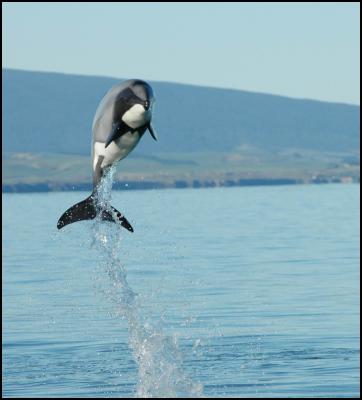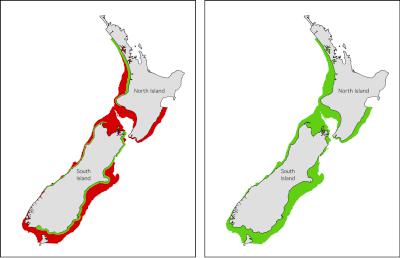Comprehensive protection required to save Hector’s dolphin

Monday 8 April 2013
Comprehensive protection required to save Hector’s dolphin
New Zealand’s heavily endangered Hector’s dolphin population could recover if protection measures were extended out to 100m deep throughout its habitat, according to a new University of Otago review.
Zoology Associate Professor Liz Slooten’s review into the effectiveness of area-based management to reduce dolphin bycatch found that such an approach can succeed if certain key criteria are met.
These include the protected area being large enough, in the right location and key threats being effectively managed as well as removing impacts from fishing rather than displacing them and ensuring no new threats are added (such as marine mining, tidal energy generation, or pollution).
The review is published in the international journal Endangered Species Research.

Left map: NZ dolphin distribution in red. Protected areas in green. New Zealand and overseas experts have urged the NZ government to 'turn the red sea green' and protect NZ dolphins out to the 100 metre depth contour, throughout their distribution (see right map).
Associate Professor Slooten says that a long-term study of the Banks Peninsula marine mammal sanctuary shows that protected areas, where gillnets and trawling are banned, can work.
“At Banks Peninsula, survival rates have increased by 5.4% since the sanctuary’s creation in 1988, and the previously rapid population decline has slowed substantially.
“However, nationwide, Hector’s dolphins continue to slide towards extinction, mainly due to continuing bycatch in areas with few or no dolphin protection measures,” she says.
Examples include the lack of any dolphin protection off the South Island north coasts, and that Hector’s dolphins range to 6 nautical miles off the west coast of the South Island, but protection only extends to 2 nautical miles offshore, and then only for 3 months of the year, she says.
Several scientific organisations, including the Scientific Committee of the International Whaling Commission and the International Union for Conservation of Nature (IUCN) have recently recommended that protection be extended out to 100 metres deep in Hector’s dolphin habitats.
“Most Hector’s do not range beyond waters of this depth. Extending protection out to this mark would largely eliminate the currently unsustainable level of bycatch.”
Associate Professor Slooten says if the measure was adopted it is calculated that dolphin populations could recover to around 15,000 within 40 years.
These are currently estimated to be 7270 South Island Hector’s dolphins and as few as 55 North Island Hector’s dolphin, which is also known as Maui’s dolphin.
ENDS


 SolarZero: SolarZero Limited (in Liquidation) - Important Business Update
SolarZero: SolarZero Limited (in Liquidation) - Important Business Update Science Media Centre: Cyclone Gabrielle's Impacts On NZ's Ecosystems - Expert Reaction
Science Media Centre: Cyclone Gabrielle's Impacts On NZ's Ecosystems - Expert Reaction RNZ: Parts Of Power System Could Be Out For 36 Hours In Event Of Extreme Solar Storm
RNZ: Parts Of Power System Could Be Out For 36 Hours In Event Of Extreme Solar Storm NZAS: New Zealand Association Of Scientists Awards Celebrate The Achievements Of Scientists And Our Science System
NZAS: New Zealand Association Of Scientists Awards Celebrate The Achievements Of Scientists And Our Science System Stats NZ: Retail Spending Flat In The September 2024 Quarter
Stats NZ: Retail Spending Flat In The September 2024 Quarter Antarctica New Zealand: International Team Launch Second Attempt To Drill Deep For Antarctic Climate Clues
Antarctica New Zealand: International Team Launch Second Attempt To Drill Deep For Antarctic Climate Clues



